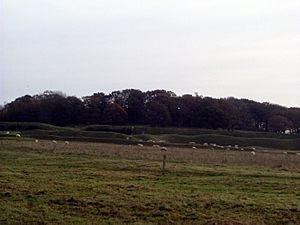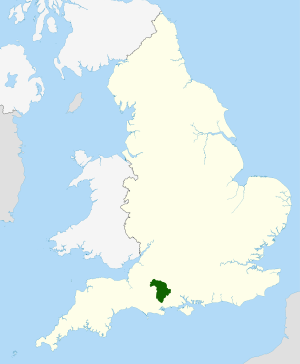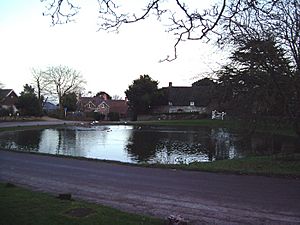Cranborne Chase facts for kids
Cranborne Chase is a chalk plateau in southern England. It stretches across parts of Dorset, Hampshire, and Wiltshire. This area is next to Salisbury Plain and the West Wiltshire Downs in the north. To the southwest, it meets the Dorset Downs. The highest point is Win Green Down in Wiltshire, which is about 277 meters (910 feet) high.
The area known as Cranborne Chase and the West Wiltshire Downs is a special place. It has been named an Area of Outstanding Natural Beauty (AONB). It is the sixth largest AONB in England, covering about 982 square kilometers (379 square miles).
Contents
History and Ancient Sites

This downland has a very long history. You can find many ancient earthworks and archaeological sites here. Some date back to the Neolithic age (Stone Age). The thick forests that once covered these hills were slowly cleared by the first farmers. Over thousands of years, the forests grew back and were cleared many times. Much of the area stayed wooded from the Middle Ages until World War II.
Scientists have found interesting things in some Bronze Age burial mounds. They think people might have used wooden pegs to keep skeletons together. This allowed them to be moved and re-buried many times.
You can find many ancient monuments from the Stone Age and Bronze Age here. These include the stone circles at Knowlton Circles. There are also remains of Iron Age settlements. The most famous is the hill fort at Badbury Rings. Archaeologists, including the TV show Time Team, have also dug up a Roman villa here.
During the Saxon invasion of England, the local people built Bokerley Dyke. This was a defensive ditch. It helped keep the invaders out of Dorset. The ditch crossed the old Roman Road that ran from Dorchester to Old Sarum.
The downs have not had many people living on them since Saxon times. This helped keep the ancient sites safe. However, during World War II, more land was needed for farming. This meant some archaeological sites were disturbed. In the 1800s, Augustus Pitt Rivers developed modern ways of doing archaeological digs here.
The area is named after the village of Cranborne. This village was founded by the Saxons. It had a large house and a small monastery. The word "chase" means a hunting ground. Kings like King John, Henry VIII, and James I used to hunt here.
Cranborne Chase was owned by many important families over time. It was even owned by the Crown for a while. Later, it was sold to families like the Cecils and the Coopers. Today, much of the Chase is still part of large estates, such as Kingston Lacy.
Cranborne Chase School was a former boarding school for girls. It was located in two different places within Cranborne Chase. It was at Crichel House from 1946 to 1961. Then it moved to New Wardour Castle until it closed in 1990.
Geography
Natural Features
Cranborne Chase is part of a "National Character Area". This is a special area recognized by Natural England. It is known as the "Dorset Downs and Cranborne Chase" area.
Hills of the Chase
The landscape of Cranborne Chase is very diverse. The most dramatic parts are where Dorset and Wiltshire meet. Here, the chalk downland rises steeply. You can see rounded hilltops like Breeze Hill (262 meters or 860 feet). The B3081 road has sharp bends as it climbs Zig Zag Hill on its side.
Another famous hill is Win Green Down (277 meters or 909 feet). Nearby, Melbury Hill (263 meters or 863 feet) stands out. It looks almost like an island rising above the flat area of Compton Abbas airfield.
Further south, there are two more hills that mark the southern edge of the Chase. These are Hambledon Hill and Hod Hill.
Wildlife and Nature
A large part of Cranborne Chase is very important for nature. About 451 hectares (1,115 acres) of the area is a Site of Special Scientific Interest (SSSI). This means it is protected because of its special plants and animals. It was first given this protection in 1975.
Some of the wooded areas in the Chase are hundreds of years old. They have many different types of plants growing on the ground. The area is also one of the best places in southern England for lichen species. More than 160 different types of lichens have been found here.
Images for kids
See also
Template:Kids robot.svg In Spanish: Cranborne Chase para niños






